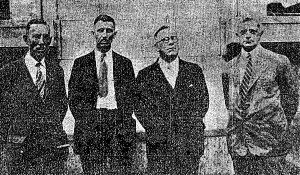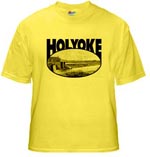by Laurel | March 31st, 2014
25 August 1929

Postmaster Horace D. Prentiss & Other Executives in Charge
Left to right: Maj. Alexander MacDonald, assistant superintendent of mails; Charles Sussenguth, superintendent of mails; James N. Murray, assistant postmaster; Horace D. Prentice, postmaster.
H. D. Prentiss Has Been Connected With City’s Postal Service for 30 Years —
Great Increase in Force and Service —
Parcel post Has Shown Greatest Enlargement —
Holyoke Picked as One of Cities for Cost Test —
The average citizen is inclined to look at the Holyoke post-mastership as a political plum — as indeed it was until the appointment of the present postmaster — and not to realize that he is the business manager of a local business doing $30,000 a month or rather over $360,000 a year. Steady growth has marked the history of the local office for a number of years; but about two years ago it ceased to grow and has only about held its own. Whether a post office is a satisfactory barometer of business in a city like Holyoke is a disputed question. In view of other indications it is quite likely to be useful as one of the factors in determining the growth or retardation of a city.
In Post Office 30 years
It is 30 years ago since Postmaster H. D. Prentiss entered the post office as clerk. There are 42 clerks now; there were then, in 1899, besides himself these others: Robert Stott, Louis Rathbun, James N. Murray, Rutherford Murray, Eugene Richter, now at the Maple Street branch, and Charles Sawyer. there are now also 49 carriers in place of the 19 then. Mr. Prentiss, by the was, was appointed acting Postmaster in August 1921, and was made a real postmaster in June 1922, so he has been postmaster a little over seven years. He was the first Holyoke postmaster to be raised to that office from the ranks. This is a policy that is being more generally followed year after year and it surely is good business. The present post office has been enlarged twice; once under postmaster Charles A. Chase, whose father Henry A. Chase was postmaster when Mr. Prentiss entered the post office work, and about two years ago when the mezzanine floor and elevator were put in. The present building has about reached its capacity and what the United States is going to do about it is not known — nothing until it has to, probably.
Parcel Post’s Increase
Of the various departments of the post office, that of the parcel post has shown the greatest increase. There are now six men employed and five trucks, though some of the trucks are used for regular mail collections nights. Out of 47 cities Holyoke was one of five selected to make regular detailed reports of the actual detailed cost of parcel post operation. This is done once a quarter. As the government reports are reports of the service as a whole in certain classes there is no separate report made as to whether Holyoke’s parcel post business is a gain or a loss; but Postmaster Prentiss believes on account of there being a balance to send to the government that it is a paying business here. Queerly enough the money order business in handled separately from the other post office departments and reported to Washington and facts and figures about it must come from Washington. The local postmaster knows about as much about it as the average reader. Letter box installations follow public demand rather than being set put like trees here and there by the post office officials. When a section grows it soon wants a letter box or two; it sends a delegation or an individual to the local post office and the postmaster and assistant generally look the ground over and decide whether that section shall have one, more than one and where it or they had better be located. Sometimes owing to shifting of population or other reasons a box is discontinued. The box farthest north in Holyoke is on Northampton Street near H. J. Toepfert’s home. The one farthest south is in Springdale.
Our postmaster was unable to state whether increasing use of the telephone had affected to a material extent the letter mail business. With telephoning now done either by special lines or a specified times by the bigger concerns a great deal of letter writing and dictation is done away with; but this sort of work is supposed to speed up orders and these might lead to further letters of confirmation and the sort. The prime use of the telephone seems to be to save time, not postage stamps.
Adapted from The Springfield Republican.
Note see more about Postmaster Horace D. Prentiss at this link.








